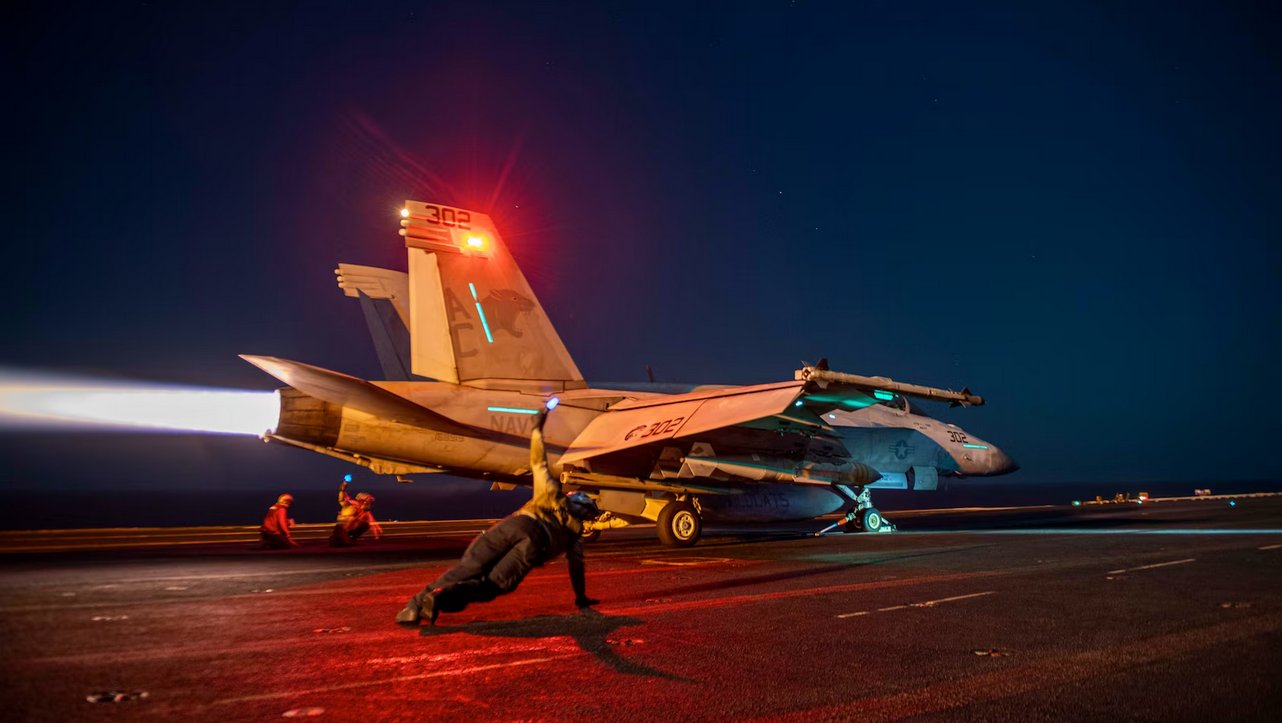

American and British forces struck 18 targets across eight locations in Yemen, the fourth large-scale bombing of Houthi-controlled areas in the last two months.
The strikes, which occurred just before midnight local time on Saturday, Feb. 24, hit targets including one-way attack drones, radars, air defense systems and a helicopter, according to U.S. Central Command. The operation also hit multiple underground weapons storage facilities as well as above ground missile storage sites. CENTCOM did not release any information about casualties in the strike, and so far the Houthi movement has not said if anyone or how many were wounded or killed in the strikes.
CENTCOM did not say how many U.S. fighter jets were used in the operation, although the United Kingdom’s Ministry of Defence said that four Royal Air Force Typhoon FGR4s were used to hit two of the eight sites. The fighter jets hit “long-range drones” that were guarded by anti-air systems. The series of strikes came after a Houthi missile hit a commercial vessel, spilling oil into the Red Sea and prompting concerns over a major ecological disaster, which CENTCOM cited in its statement on the operation.
“These strikes from this multilateral coalition targeted areas used by the Houthis to attack international merchant vessels and naval ships in the region. Illegal Houthi attacks have disrupted humanitarian aid bound for Yemen, harmed Middle Eastern economies, and caused environmental damage,” the statement read in part.
Subscribe to Task & Purpose Today. Get the latest military news and culture in your inbox daily.
On Feb. 18, Houthi missiles hit the merchant vessel Rubymar (owned by the U.K. but flying under the flag of Belize). The crew was safe but forced to abandon the ship. Since then, the Rubymar took on water, and started leaking oil, leaving a mile-long oil slick in the Red Sea, according to CENTCOM. Additionally, the ship is carrying more than 40,000 tons of fertilizer, presenting a potentially even greater risk to the environment in the area.

Saturday’s airstrikes are the fourth operation targeting Houthi sites since Jan. 12. Smaller shootdowns, involving ships and fighter jets operating in the Red Sea and Gulf of Aden have destroyed anti-ship missiles, aerial and maritime drones in operation or about to be launched from Yemen, but have not been the large-scale attacks that have occurred in the last two months. So far the operations, explicitly meant to degrade Houthi capabilities and get the group to stop targeting commercial ships, has failed to stop the attacks.
The Houthi movement, which controls a large portion of Yemen including its major cities, began attacking commercial ships in October, saying it intended to stop maritime trade to and from Israel in response to the country’s war in Gaza. In response, the United States and allied partners sent additional ships and aerial assets to the Red Sea and Gulf of Aden. That in turn has prompted wider Houthi action, with its spokesmen saying they consider British and American ships valid targets. The group has carried out more than 40 attacks on vessels traveling through the waters near Yemen, and commercial shipping has been disrupted as companies take longer routes to avoid the region. Both sides vow to continue their actions until the other side stops.
So far no one has been killed as a result of Houthi attacks on commercial ships. The exact number of deaths from American and allied strikes on Yemen are unclear. At least 17 Houthi fighters were killed in the strikes conducted on Feb. 10.
The latest on Task & Purpose
- The Air Force wants retirees to help fill gaps in the service
- Navy allows sailors to put hands in pockets as hell freezes over
- The Army’s next-gen combat helmet is now arriving with soldiers
- Navy now allows sailors to wear leggings under PT shorts
- Legendary Marine Scout Sniper Chuck Mawhinney dies at age 75